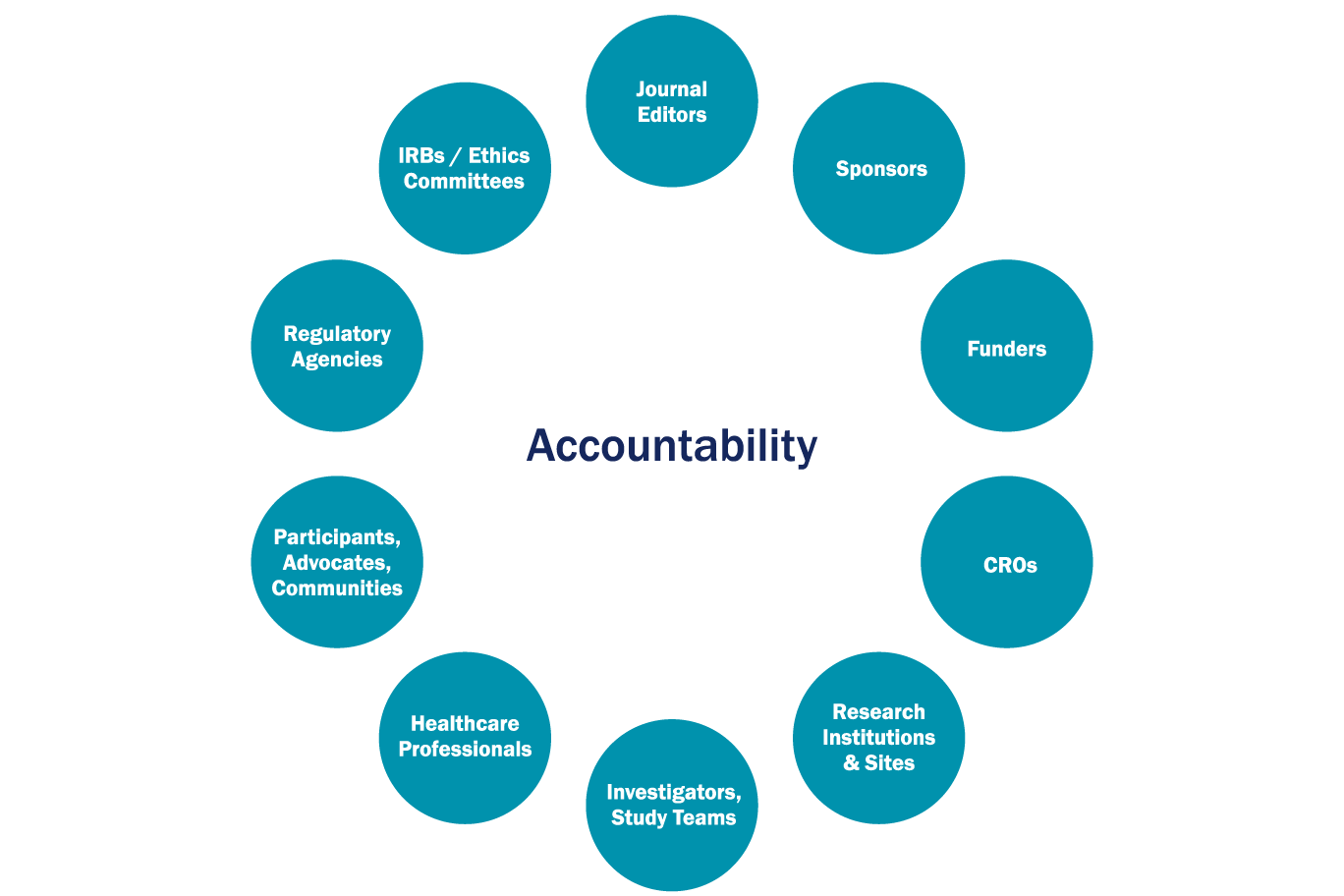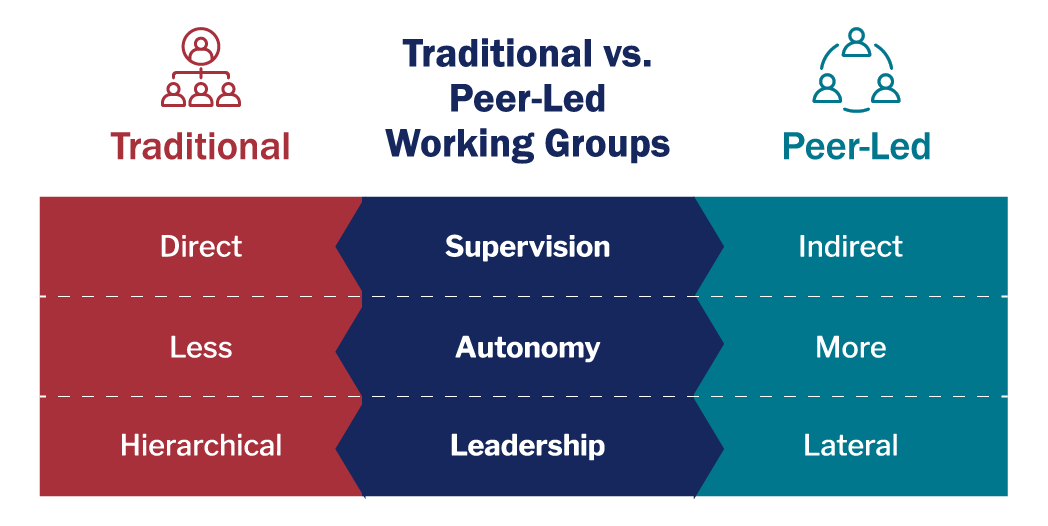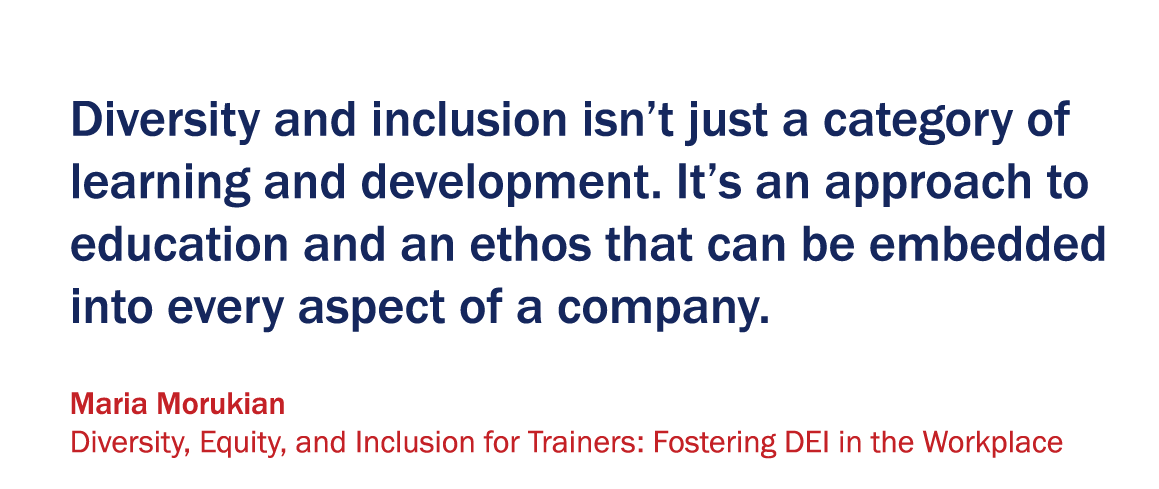Using Peer-Led Working Groups to Advance Equity
Since 2020, Harvard Catalyst Education has implemented a peer-led working group model to address and support diversity, equity, inclusion, and belonging (DEIB) across our program. Below, we describe our motivations behind this approach, the launch and evolution of our working group model, and resources for further study. If you are interested in learning more, please contact us at education@catalyst.harvard.edu.
Background
Disparities and inequities in clinical and translational research are well-documented, which range from the composition of the workforce itself, to ethical study design and equitable recruitment of research participants, to bias in the funding process. Addressing these critical needs requires a systemic, multi-faceted approach. The Multi-Regional Clinical Trials Center of Brigham and Women’s Hospital and Harvard provides a useful accountability model (below) illustrating the many stakeholders in the clinical research enterprise who are responsible for improving diversity, equity, inclusion, and belonging.

The graphic above is adapted from Bierer B.E., White S.A., Meloney L.G., Ahmed H.R., Strauss D.H., Clark L.T., (2021). Achieving Diversity, Inclusion, and Equity in Clinical Research Guidance Document Version 1.1. Cambridge and Boston, MA: Multi-Regional Clinical Trials Center of Brigham and Women’s Hospital and Harvard (MRCT Center). View guidance document.
The authors of the extensive guidance document Achieving Diversity, Inclusion, and Equity in Clinical Research write that “All [stakeholders] are accountable for their role in the effort and share, albeit with different responsibilities and functions, toward success. No single entity can achieve diversity alone; if it is not an affirmative commitment of all, insofar as their specific contribution to diversity may be important or impactful, it will fail.” (Bierer et al., 2020).
As a stakeholder at Harvard University and its affiliate academic healthcare centers, our program offers a broad range of courses, workshops, programs, and digital resources to meet the needs of clinical and translational research teams, both within and outside of university research communities.
Our offerings frequently make available important resources for researchers such as regulatory agencies, publishers, and funding mechanisms. By addressing multiple dimensions of DEIB in our work, our program is uniquely positioned to influence what people learn (the content), as well as how they learn it (in inclusive, accessible spaces) and from whom (a range of perspectives). Further, our staff’s team science approach to content development and design is strengthened when we apply a DEIB lens to our own recruitment and staff training.
What are Peer-Led Working Groups?
Simply put, a working group is composed of several people who have been tasked with overcoming a problem. A working group’s deliverables, milestones, communication channels, and lifespan are based entirely on their goals. The working group model can be a particularly effective strategy for addressing high-stake problems and goals, including addressing diversity, equity, inclusion, and belonging. When implemented across a department, team, or organization, the working group model allows for multiple problems to be addressed simultaneously, organizing all staff members into smaller working groups. When it comes to DEIB work, initiating a working group model encourages healthy shifts in workplace culture, normalizing conversations.
Importantly, working groups are composed of people who offer diverse perspectives and experiences; in a workplace, the membership of an individual working group benefits from including people who perform distinct job functions. A peer-led working group leverages the diversity of its members by moving away from traditional, hierarchical structures that can impede innovation and creativity.

Peer-led working groups rely on lateral leadership, wherein there is no single leader or decision-maker. Unlike hierarchical dynamics that influence how work is assigned and evaluated elsewhere, the work that happens within a peer-led working group is managed within the group itself. As a result, peer-led working group members experience increased ownership and accountability of their work together; they build capacity, creativity, and trust, and they benefit from mutual learning and growth opportunities they work toward solutions.
The content above is adapted from a presentation given at the Learning 2022 Conference, titled “Use Peer-Led Working Groups to Advance Equity in Learning Design & Delivery” by Vanessa Hazzard. View the full presentation here.
Creating a DEIB Plan
In 2020, our leadership embarked on creating a multi-faceted strategy to provide direction and structure to existing diversity, equity, inclusion, and belonging (DEIB) efforts happening across the team. After hosting staff discussions, our leadership revised our value statement to ensure that it appropriately reflects our commitment to DEIB.
Harvard Catalyst Education Program Value Statement
Harvard Catalyst Education Program believes that the successful translation of discoveries to impact human health requires life-long education, training, and mentoring. We focus on continuous development of a diverse workforce across the translational spectrum by generating the necessary resources and experiences for CT investigators to be successful in a complex research (biomedical, behavioral, and clinical) environment.
Next, our leadership team developed a set of goals to address how our team could best uphold the updated value statement in practice. Leadership, in collaboration with staff, considered how we could effectively and equitably meet these DEIB goals. The results were a plan that included foundational staff training, updated annual program goals, and a proposed working group structure through which more specific goals and deliverables could be addressed. The plan helped establish “DEIB work” as a shared responsibility; through the working groups, each team member was expected to actively engage in work towards achieving our broader team goals.
Although the implementation of the working group model was a collaborative effort among staff, it was “leadership-driven,” by which we mean it was the result of ongoing discussions and decisions by our administrative directors, with additional input by our two faculty directors. We feel strongly that this leadership buy-in was essential in launching this model and helping to set an expectation that every team member was expected to participate and share ownership of upholding our value statement.
Launching and Sustaining the Working Group Model
It is important to note that the implementation process has not been linear; it has been continually adjusted and rerouted. The working group model is agile, and our team has regularly adapted as necessary. As individual groups meet their goals, as staffing fluctuates, and as new goals and needs arise, our leadership team initiates changes to best suit our goals as a team. Below, we describe the initial launch of the model, as well as its evolution over time.
Peer-led working group topics were informed by our curriculum development process, operational workflows, and DEIB goals. Each group was formed with representation from a diversity of roles, often assembling teams of staff who do not typically work closely together. Groups were initially formed in the fall of 2020. Each group had a set of broad goals that corresponded to our program’s DEIB goals. As the groups made progress towards these goals, updates were circulated via Slack, email, and to existing process and workflow documents. About two years after initiating the working group model, our staff met to share updates and progress from each of the working groups. This provided an opportunity to reflect on what had been produced, solicit feedback on deliverables, and plan for future goals and next steps.
Priorities that informed our peer-led working groups*
- Content and curriculum: Develop resources and standards to support inclusive curriculum design practices.
- Participant recruitment: Expand our learner network, with the goal of increasing the participation of people from historically excluded communities and underrepresented groups.
- Faculty recruitment: Expand our network of faculty and expert collaborators to reflect the diverse voices in the clinical and translational workforce.
- Staff training and professional development: Identify the professional development needs of Harvard Catalyst Education program staff and develop/vet existing resources to meet those needs.
- Hiring: Implement inclusive hiring practices to build a diverse team.
*Since launching the working group model in 2020, some of these priorities have evolved. New groups have been formed as needed to address emerging priorities. For more information about current group topics, goals, and deliverables, please contact our team at education@catalyst.harvard.edu.
Working group composition has also evolved over time. During the initial launch, most working groups included at least one member of our leadership team, which helped establish some structure and direction, as well as provide clear channels and connections back to the broader plan. Two years later, those in leadership roles exited the now-mature working groups, increasing the opportunity for groups to exercise lateral leadership described above. In this new variation, each working group meets with the entire administrative leadership team at regular intervals to provide updates, ask for help, and share feedback.
Looking Ahead
While the process described above may appear linear, our program is dedicated to addressing DEIB through an approach that is flexible to shifting needs, staffing, and priorities. If you are interested in learning more about our implementation of the peer-led working group model and/or collaborating with us on our efforts, please contact our team at education@catalyst.harvard.edu.

Additional Recommended Resources
- The Race, Equity, & Inclusion Action Guide published by the Annie E. Casey Foundation offers definitions of key terms and strategies for advancing and embedding equity and inclusion in an organization.
- Getting Executive Leadership Buy-In for your Diversity, Equity, and Inclusion Strategy, a blog post by Samantha-Rae Dickenson, EdD, MPH, describes a model for achieving leadership buy-in for DEI initiatives.
- The Diversity, Inclusion, and Equity in Clinical Research Project by Multi-Regional Clinical Trial Center of Brigham and Women’s Hospital and Harvard includes extensive guidance, useful tools, and practical case studies to support improvements in DEI in the clinical research enterprise.

